SUMMARY
This is AI generated summarization, which may have errors. For context, always refer to the full article.
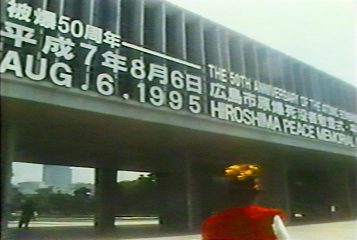
Wow! Its 75 years na pala since the Hiroshima bomb exploded! On 6 August 1945. Yes, I was almost 3 years old. Parang kahapon lang. It’s funny to realize that today, in my ripe old 77th year – age-wise – ako pala ay kuya ng first Atomic bomb (nicknamed “Little Boy” by the bombing crew.)
Over 140,000 Japanese souls were then catapulted into their next incarnation by one American bomb. Isa lang! Compare this to the hundreds dropped during the carpet-bombing of Baguio in 1944. I survived that – as a 30-month old baby. Siguro I was just mouthing my first words. (Surely Bomba was not in my initial vocab.)
Whether in small-town Baguio or in metropolitan Hiroshima, the trauma of World War 2 (WW2) can be a heavier burden to the survivors than to those who perished. For the 75th memorial of that infamous day in 2020, sigurado ako, large Japanese crowds, and international dignitaries gathered at the Hiroshima Park.
25 years ago… A Cordillera ritual at the Hiroshima Park
25 years ago, a group of Cordillera artists prayed in Hiroshima. Palibhasa, it was the 50th anniversary of the A-Bomb on 6 August 1995. We did an artistic ritual in Hiroshima Park– near the epicenter of the explosion. At the Westend of the Park was the official gathering of heads of state and diplomats.
Countless Never-Again speeches were spouted. Some were heartfelt. Others, merely palabas blah-blahs by leaders of nuclear nations. Pero alam nila sa kaloob-looban – the realpolitik of detente demands an arsenal of nukes. Laging Handa!
Ang tunay na Kapayapaan, sa totoo– ay hostage ng mga super-praning. (‘Little Boy’ mentality, diba?)
With Igorot gongs ringing loud, ours was a wordless ritual. Symbolically we had planted 3 giant acupuncture needles— each 9 meters tall. The intention behind these iron needles was to help heal the nuclear wound left behind in Hiroshima. Silently, we were also praying for the last lingering souls left behind – unable to find their way home after that violent shock 5 decades ago. Sana they would find their way into the next life.
Yes, a sort of spiritual send-off.
Healing Our Planet (H.O.P.E)
Acupuncturing the earth was the brainchild of Baguio artist Roberto Villanueva: 9 copper needles were to pierce the soil. Each needle had a hole (at ear-level) so spectators could listen to our planet’s murmurs (or is it moans?).
The installation was to re-connect man with nature. What better place than Hiroshima – where the greatest wound inflicted on our planet happened in 1945. (Hiroshima’s modern skyline has camouflaged the devastation of 1945. But the inner scars run deep.)
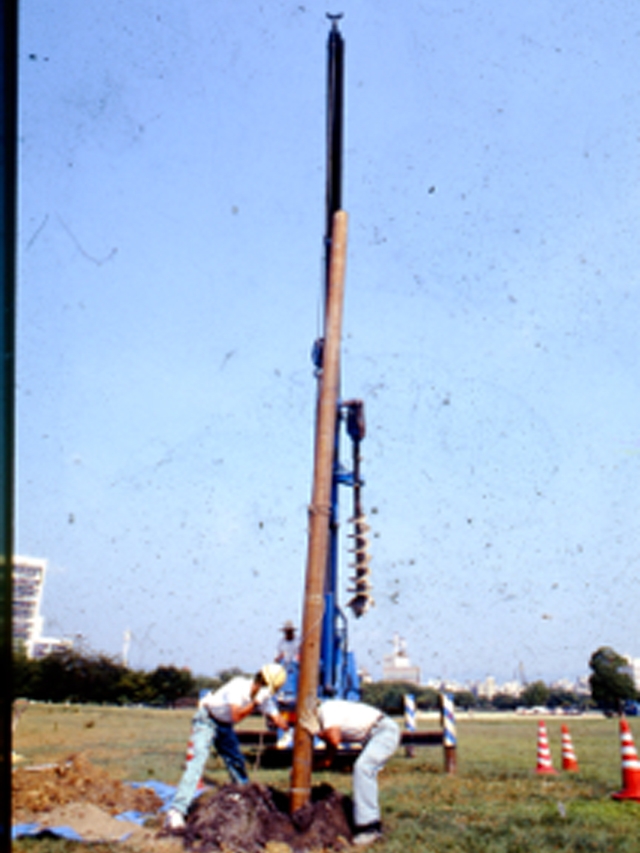
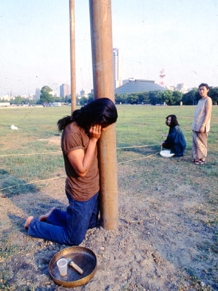
The acupuncture art project entitled Sacred Sanctuary, was approved for installation. However, while Art Front Gallery was raising funds for copper needles, Roberto died in 1994 of Leukemia. He did not live to see his giant needles materialize.
But his dear soul mate Midori Yamamura saw the deep symbolic impact of installing it during the 50th Hiroshima event. She arranged logistics to erect 3 interim iron needles. She also invited our Cordillera delegation to imbibe indigenous spirits into the installation. All preparations (including permits from the city) were singlehandedly pushed through with her personal energy and finances.
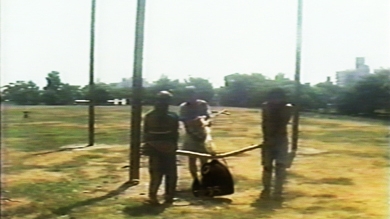
It was Midori’s tribute to Roberto’s creativity and his artistic commitment to Gaia Consciousness. The ecological significance of the A-Bomb is lost to historians– who frame it merely as a victory weapon. Alam ni Roberto the physical damage in Hiroshima (and later, on 9 August in Nagasaki) was clearly a brutal devastation by a technological monster, insensitive to Earth’s fragility.
The ear-holes to the underground pain were Roberto’s way to facilitate an “exchange of healing energies between the participant and the earth.” Hearing the hum of Gaia was a strategy to be aware of humanity’s impact on the earth in our era (known also as the Anthropocene).
Yes, to possibly stop another nuclear rape of nature.
Our “Bomb Mission” to Hiroshima
To complement Roberto’s needles in Hiroshima Park, we decided to bring a bomb from Baguio. Yes, a WW2 bomb-head which was converted into a church bell.
Six months before our Japan trip, my Ifugao mentor Lopes Nauyac had found an intact bombshell. Palibhasa, during the 1944 carpet bombing raids, one bomb had overshot Baguio – into the Asin river. Unexploded, it slept 50 years in the riverbed.
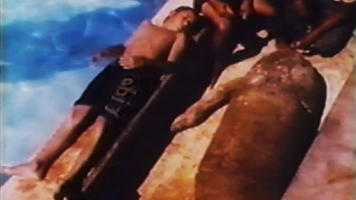
In 1994, Nauyac had built a chapel for his community. Kelangan ng simbahan isang bell, to call the parishioners on Sunday. So, he patiently sawed off the cast-iron head of the bomb. Walang machine grinder sa buong parish. Hacksaw blades ang ginamit niya – 3rd world style.
After 2 weeks of sawing the bomb with ear-smothering sounds, Nauyac got his church-bell. For the next 6 months the bell summoned Asin’s churchgoers. Then we borrowed the 108 kilo bell, packed it with our Ifugao gongs and bahags. And six of us checked-in for our Hiroshima flight.
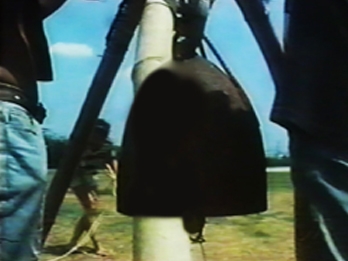
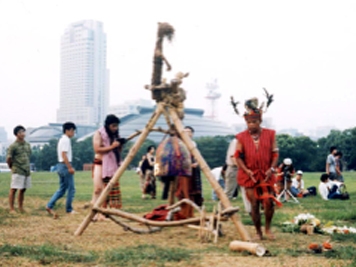
Our Hiroshima crew came from the Baguio Arts Guild. Malaki ang age range – from Ifugao Elder Lopes Nauyac (61), to my Baguio-born son Kawayan de Guia (16). Kasama ang Cordi musicians Arnel Banasan and his bayaw Raffy Kapuno (who passed away last month). Kasali din si Rene Aquitania our veteran performance artist, plus myself – as video documenter. Armed with our gongs, nose flutes, kubings and tungatongs (plus the bomb bell!), we were confident our music could summon the Spirits for this auspicious peace ritual.
On the eve of the event, we erected a bamboo tripod from which we hung the bell. At dawn, Japanese friends, artists and Shinto pilgrims gathered. Precisely at 8:15 AM (the time of the explosion 50 years ago) — we had a few minutes of solemn silence. Unti-unting pumapasok ang kalmadong noseflute.
Biglang sabog ang katahimikan. Indigenous gongs crescendo into a loud prayer. Heto na! We dance around the needles our bahags waving wildly behind us. Buhay na buhay ang Sacred Sanctury ni Roberto!

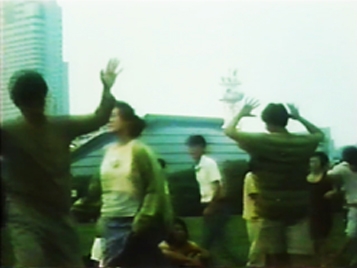

Soon Japanese folk join our Cordi dance, calling in their Nippon deities— who can help free the last souls stranded since 1945. One by one the Japanese kneel solemnly before the bell tripod. Each one pulls the cord so the bell makes a beautiful bongggg! Ang lalim ng ugong! – a prolonged resonance before the 30-second drone tapers off. Each pilgrim with folded hands says a prayer– egging stranded souls to move on.

Memories ng isang War-Baby
At the start of this flashback to WW2, na-discover ko, kuya pala ako ni Little Boy — the bomb that ended the war. Yes, I was conceived just after Pearl Harbor. Palibhasa their Tora-Tora planes flew south towards us, the colony of their American enemies. On Dec 9, 1941, the very first Japanese bombs dropped in Asia, fell at Camp John Hay gate. Na-bulabog ang mga taga-Baguio… including my soon-to-be grandmother.
Kasi ganito yun: si Mama, 3 years lini-ligawan ni Papa ko. Pero kasi bagong UP Law graduate, she wasn’t ready to settle down. Umu-usok pa ang bombs sa John Hay gate, advise ni Lola kay Mama: “Gene anak, mukhang may Guerra na… It might be good to have a man around the house.”
Two weeks later on Dec 26 1941, Mama and Papa married. And, 9½ months later – guhit ng tadhana – I was born. Yes, while the war to end all wars was raging. Ayan na! In the most literal sense of the word, talagang blue-blooded war-baby ako.
Wala akong war wounds. Walang conscious memories of the war. Pero feel-na-feel ko yung sense of horror, in Mama’s embrace, habang mga B-29 bombers palapit sa Baguio. The drone of monster machines, louder and louder, was a palpitating prelude to fireworks – in full-blast Dolby Sensurround!
A three-year old does not understand death. But fear is learned easy without words.
Lopes Nauyak has a bomb shrapnel wound on his forehead. 8 years-old lang siya, when the American B-29s pounded the rice terraces of Hapao — trying to flush-out General Yamashita. Hindi lang maraming Ifugao innocents na-tepok. Pati rin ang ancient rice terraces — food security since 3 millenia — wasak!
Ganito ang malas ng survivors: With the loss of ancestral rice fields, they will suffer hunger for generations. And the dead, they rest in peace — walang gutom. Ganoon din sa Hiroshima. Kawawa ang mga Hibakusha— those A-bomb survivors who die a slow death of post-1945 radiation. Innocents must endure a life of shame with their body burns and hideous scars.
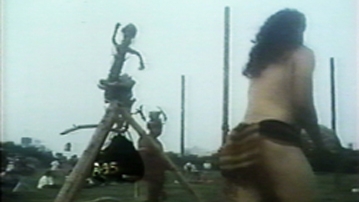
Nauyac’s vivid memories, together with my unconscious traumas – nag-playback siguro sa Hiroshima, noong 6 Aug 1995. Baka ang ritwal namin ng pag-kaladkad sa 108 kilo bomb-bell sa Japan, ay parang panata. Kaya siguro gumaan ang post-war baggage namin.
Might it be, that a recycled bomb-bell, tolling for the peace intentions of each pilgrim, offered hope to us who took part in the Hiroshima ritual — Hope that the bombs of the ‘war-to-end-all-wars’ will now be a thing of the past?
This 77-year old war-baby would like to believe that! Sana, yun na nga! – Rappler.com
You can view Kidlat Tahimiks Video Essay “Our Bomb Mission to Hiroshima” here.
Add a comment
How does this make you feel?
There are no comments yet. Add your comment to start the conversation.